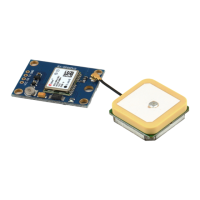LEA-6 / NEO-6 - Hardware Integration Manual
GPS.G6-HW-09007-A Preliminary Design-in
Page 19 of 62
GPS receivers require a stable power supply, avoid ripple on VCC (<50mVpp)
For low power applications using Power Save and backup modes, ensure that the power supply or low ESR
capacitors at the module input can deliver the required current/charge for switching from backup mode to
normal operation. In certain situations charging the internal capacitors in the core domain can result in a
significant instantaneous current draw.
Backup Battery
For achieving a minimal Time To First Fix (TTFF), connect a backup battery to V_BCKP.
Antenna
The total noise figure should be well below 3dB.
If a patch antenna is the preferred antenna, choose a patch of at least 15x15x4mm. For smaller antennas
an LNA with a noise figure <2dB is recommended, this can increase sensitivity up to 2dB. To optimize TTFF
make use of u-blox’ free A-GPS services AssistNow Online and AssistNow Offline.
Make sure the antenna is not placed close to noisy parts of the circuitry. (e.g. micro-controller, display, etc.)
For active antennas add a 10R resistor in front of V_ANT
5
To optimize performance in environments with out-band jamming sources, use an additional SAW filter.
input for short circuit protection or use the
antenna supervisor circuitry.
For information on ESD protection for patch antennas and removable antennas, see section 3.3.4 and if
you use GPS for design in combination with GSM or other radio then check sections 3.3.6 to 3.3.8.
For more information dealing with interference issues see the GPS Antenna Application Note [4].
Schematic
If required, does your schematic allow using different module variants?
Don’t drive RESET_N high!
Don’t drive configuration pins high, they already have internal pull-ups.
Plan the use of 2nd interface (Testpoints on UART, DDC or USB) for firmware updates or as a service
connector.
Layout optimizations (Section 2.4)
Is the GPS module placed according to the recommendation in Section 2.4.2?
Has the Grounding concept been followed (see Section 2.4.3)?
Has the micro strip been kept as short as possible?
Add a ground plane underneath the GPS module to reduce interference.
For improved shielding, add as many vias as possible around the micro strip, around the serial
communication lines, underneath the GPS module etc.
Have appropriate EOS/ESD/EMI protection measures been included (see Section 3.3)? This is especially
important for designs including GSM.
Calculation of the micro strip (Section 2.4.4)
The micro strip must be 50 Ohms and be routed in a section of the PCB where minimal interference from
noise sources can be expected.
In case of a multi-layer PCB, use the thickness of the dielectric between the signal and the 1st GND layer
(typically the 2nd layer) for the micro strip calculation.
If the distance between the micro strip and the adjacent GND area (on the same layer) does not exceed 5
times the track width of the micro strip, use the “Coplanar Waveguide” model in AppCad to calculate the
micro strip and not the “micro strip” model.
5
Only available with LEA-6 modules

